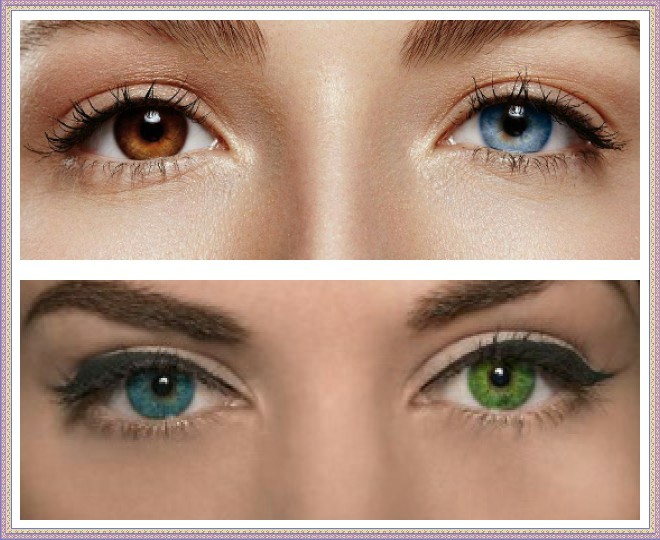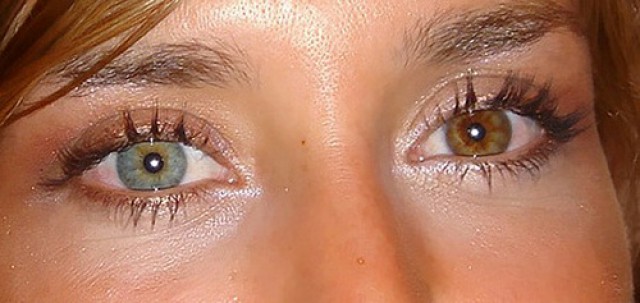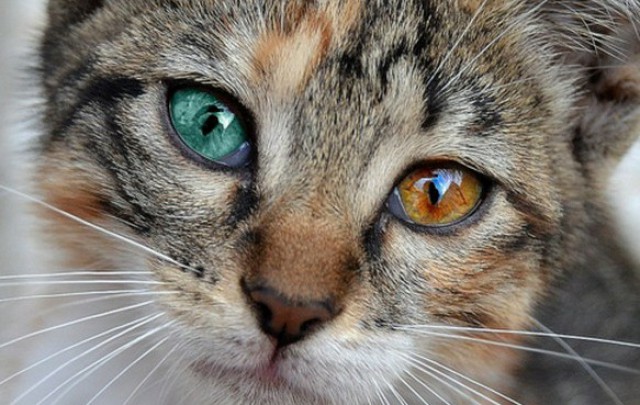What is the name of the disease when people have different color eyes? Hypochondria or how to invent a disease
The main task of the World Health Organization is, of course, to protect humanity from disease on a global scale. But in the spring of 2015, she defended the reputation of individuals, teams, geographic regions, localities, and even animals.
The new guidelines for naming human diseases suggest that, if possible, the names of diseases should not include names, occupations, place names, names of animals and food products, as well as terms that can frighten the patient. In the designation of the disease you can mention the symptoms (say, as in the name "typhus"), seasonality of the disease, the names of pathogenic microorganisms, you can also use different indexes such as 1, 2, alpha, beta, gamma, and so on. So, Marburg fever (a city in Germany where it was first registered and described) should now be called “hemorrhagic fever-1 associated with filovirus,” and Ebola fever (along the river in Zaire) - “hemorrhagic fever-2 associated with filovirus.”
The Commission, which developed the recommendations, met several times, discussing a variety of proposals. For example, to call diseases the names of ancient Greek gods, as they do with asteroids. Or by male and female names like hurricanes and cyclones.
Australian epidemiologist Linf Wang is well aware of the need to eliminate geographical names from the nomenclature of diseases. Twenty years ago, he described a viral disease, calling it Hendra's disease at the place of its first detection - the suburb of Brisbane. Until now, Wang receives angry letters from residents of the suburbs: after the publication of such a name, the value of real estate in Hendra fell markedly. If spotted fever of the Rockies is called mountain fever, it will be possible to hope for an increase in the flow of tourists to these picturesque mountains.
Swine Flu has led to the massive slaughter of pigs in many countries. The same with bird flu.
The name "Arab SARS" offended a whole nation. She was renamed MERS, the respiratory syndrome of the Middle East, which offended a large region, discouraged many tourists from wanting to visit his country. Although in principle acronyms (short names in the first letters of a few words) are a good way out if they are not deciphered to the general public.
The Norwalk virus, named for a city in Ohio (USA), angered the townspeople. Renamed Norovirus. Here the Japanese were offended: Noro is a surname common to them.
It is not clear how to deal with the old, long-established names of certain diseases. Many of them are given in honor of the original writers: Alzheimer's, Botkin, Parkinson's, Kawasaki ... Perhaps they took it as an honor and recognition, but do such names of the namesakes of these names offend these scientists?
A difficult case - the dance of St. Vitus. The name is given by Paracelsus. Obviously insults the feelings of believers (Saint Vit is revered by the Orthodox Church). True, the name “Chorea of Seidenham” has long been used, but in English-speaking countries there is a lot of namesakes of this English doctor of the 17th century - why are they so?
The following log messages are used:
Economist, Fortean Times and New Scientist (UK)
Bild der Wissenschaft (Germany), Astronomy, Science News,
Scientific American and Wired (USA), Ça m’interesse and Science et Vie (France)
People with an unusual detail of appearance, different eye color, can look very eccentric, and I must say that this anomaly is quite rare, it is found only in 1% of the population of the Earth. Different eye colors cause different reactions in people, some even find this phenomenon attractive and do not worry about it at all. US actress Mila Kunis received the title of “The Sexiest Woman of 2012”, although her eyes are of different colors, and quite radically - one blue eye, the other brown.
A disease when the eyes are of a different color is referred to as heterochromia in the medical literature and is much more common in animals than in humans.
For the most part, “a disease of different eye colors” is not a disease as such, and its owners live a full life, see and perceive colors as well as people without heterochromia.
This anomaly is found in both women and men, but according to statistics, it is the beautiful half of humanity that is more susceptible to heterochromia.
The essence of the phenomenon, or why people may have different eye color
Eyes of different colors, or, as this condition is also called, heterochromia (from the Greek ε ε ς ς– “different”, “different”; χρῶμα– “color”), are characterized by unequal presence of the coloring pigment in the eye iris. Because of this, people and animals can observe different eye color.
"Disease of different eye colors" is transmitted through the human genome and, sometimes, manifests itself after many generations. This fact is best known to people who are engaged in the breeding of purebred animals, because not only people with different eye colors can be carriers of specific genes.
Types and forms of heterochromia. What is the name of the disease when the eyes of different colors are not from birth?
When a person has different color eyes, what is the name of this disease? This question interests many, except for the designation “heterochromia of the eyes” definitions are few. Often this condition is divided into congenital, caused by genetic mutations, and acquired, resulting from the disease. In this case, in the first case, the diagnosis will be difficult, because the final color of the child's eyes is established by two years.
Why can a person have a different eye color?

The disease, when the eyes are of different colors, can occur in many cases and may well manifest itself in a healthy person, due to eye damage. In this case, it arises from the fact that the cervical sympathetic nerve is weakened from birth. And it can also be complicated when a chronic disease that affects one eye caused a heterochromia. This can also be one of the answers to the question why the eyes are of different colors.
When a person has eyes of different colors, what is the name of this anomaly, if the word heterochromia is not enough? This may be metallosis, we will tell about it in more detail later. And now it should be noted that with any type of different eye color complications are possible. They are more characteristic of the complicated type and can lead to Bernard-Horner syndrome when the pupil of the patient narrows and, in addition, the position of the eye in orbit can shift. In this case, heterochromia indicates a disease that urgently needs to be treated.
Why do people have different eye color and can it be called a disease?
One of the reasons why people can have different eye color from birth is metallosis. Hitting a fragment of iron in the eye of the neck of something with siderosis, and copper - with chalcosis. At the same time there is pigmentation of the eye, manifested in the acquisition of the iris green-blue or rust-brown hue. In this case, the foreign body must be urgently removed. If inflammatory processes occur after this, it is recommended that corticosteroids be administered to the patient.
What types of heterochromia occur in people with different eye color?
It is known that with congenital heterochromia it is impossible to restore the color of the iris. And even with an acquired eye color, it has a chance to return to the original one only if such a condition has arisen as a result of ingress of a foreign fragment, that is, in the case of a change in the iris during metalosis.
Different eye colors in people: what is the name, its variety?

The types of heterochromia are classified according to the degree of coloring of the iris: complete, sector and central.
- Full - both eyes of different colors. The most common is the type in which the eyes are hazel and blue.
- Sectorial - the color of the iris includes several different shades.
- Central - the presence of several colored rings in the iris.
In addition to the pathological cases of acquired heterochromia, the disease should not be afraid - it does not affect the vision and human health in general.
A remarkable fact: women are more “sick” with heterochromia than men. Complete heterochromia, as a rule, is more common than partial.
Different eye colors in people: what is the name of this condition if the disease is acquired
Sometimes people with different eye colors complex because of their "illness". In order to hide their unusual feature, they resort to the use of contact lenses: with well-chosen shades of lenses, the color of the irises can be aligned and the identity of the colors of the right and left eyes can be achieved.
However, in fact, there is no reason to be ashamed of this unusual feature of appearance. Proof of this thesis can serve as examples of such celebrities as Jane Seymour, Michael Flatley, David Bowie, Simon Pegg, Mila Kunis, Henry Kevill, Kate Bosworth and Alice Eve. These people, despite their non-standard appearance, were able to achieve success and live with different colors of the eyes, making it their highlight.
According to legend, Alexander the Great himself suffered from heterochromia. Different color of eyes symbolized the power of nature and extraordinary mindset of the great commander.
An example of heterochromia in literature can be Tristan from legends, the lieutenant from the “White Guard” Myshlayevsky and Woland from the novel “The Master and Margarita” by Bulgakov - “The right eye is black, the left one is for some reason green”.
What is the name of the disease when the eyes are of different colors: a heterochromia in history

Interest in why people have different eye color, appeared in the distant past. However, then medicine was not yet developed enough to explain the causes of such a phenomenon as eyes of different colors, and tell the masses what it is called. Therefore, unable to find an answer to the question of why a person has a different eye color, people from the common people, having a mystical mindset, considered heterochromia to be a manifestation of something supernatural.
In ancient times, people with different eye colors caused others to have superstitious fear. They were proclaimed "creatures of the devil", "sorcerers" and attributed all the troubles happening around them to their account. Parents of children with heterochromia of the eyes were suspected of having links with evil forces and black magic. Some, at the sight of a person with unusual eyes, even began to read special prayers and plots so that they would not be in trouble or over the evil eye.
Superstitions about people with unusual for surrounding eyes of different color have come to our days. For example, the fact that it is impossible to quarrel with a person with multi-colored eyes, because he is protected from evil intent by an unknown force and evil thoughts directed at him will return to the address back. And the owner of this power, most likely, does not consciously use it and is completely unaware of it.
In addition, there are beliefs that women with heterochromia are prone to a rewarding way of life, but, having met “their man”, they turn into trustworthy and faithful spouses.
Heterochromia in animals

Different color of the eyes of a person, as they say - with such a request, people often turn to search engines, and subsequently learn a lot about our younger brothers. The unequal color of the eyes, or, as this phenomenon is called, heterochromia is a phenomenon that affects not only humans, but also animals. Moreover, the latter such phenomenon is much more common.
Cases of complete heterochromia are more common than sectoral.
Different colors of irises - often one blue eye - can most often be observed in cats. Moreover, cases of heterochromia are most likely in their representatives with white color, both full and partial. As mentioned in the leash, Prophet Mohammed's beloved cat was Muizz, who had multicolored eyes.
Heterochromia is most commonly found in Turkish Angoras and Van cats. Among the dogs most heterochromic are the Siberian Huskies. And the Australian Shepherd and Border Collie sometimes have partial heterochromia.
Although many people like the appearance of animals, which have a different, unusual looking eye color, it is noteworthy that breeding animals with heterogeneous eyes among breeders is not encouraged - this is considered a breed marriage.
However, be that as it may, in the conditions of modern society, cattle breeders are perceived as completely normal, their peculiarity is no longer unacceptable and, if you have such a strange outward appearance from birth, you shouldn’t hide it hesitate.

If heterochromia suddenly manifested itself in you or your loved ones, although this phenomenon has not been observed before, you should consult a doctor to diagnose and treat possible diseases that could cause the eye color to change, because the question why people have different colors The eye can find many answers.
Health
There are a number of diseases that doctors attribute to "strange cases." Some consider them contrived, however, patients do suffer, and medicine is powerless to do anything. For example, long-term unwanted orgasms, inability to experience fear or strange growths on the skin.
Morgellon disease: there is someone
Probably, each of us in life got into situations from which goosebumps ran. However, there are people who actually believe that they have something running under the skin. Morgellon disease is not yet a well-studied disease in which people feel that they have something to move, bite and crawl under the skin. The unfortunate see that they have hair or hair, they also have wounds on their skin, they get tired quickly, suffer from memory loss.
The cause of the symptoms has not yet been established, however US Centers for Disease Control and Prevention (Centers for Disease Control and Prevention) seriously tackled the problem back in 2008. The medical community is divided: some doctors believe that the symptoms are caused by mental illness, but others are convinced that the patient has skin problems, as reported by the Mao Clinic (Mayo Clinic).
Some health experts claim the disease is caused by an unknown infection. However, others say that this theory is not confirmed, since most patients have no signs of infection (for example, there is no elevated white blood cell count). So the study showed, the results of which are planned to be published in February in the journal American Journal of Clinical Dermatology.
Stranger's hand syndrome: my hand does not obey me
 In film "Dr. Strangelove" It tells the story of a man whose right hand seems to be "living his life." In fact, this occurs in reality, the disease is called "the syndrome of someone else's hand." In patients, usually one of the hands may take or touch something against the patient’s desire, what is said in the description of the disease, made in 2004 in the journal Archives of Neurology.
In film "Dr. Strangelove" It tells the story of a man whose right hand seems to be "living his life." In fact, this occurs in reality, the disease is called "the syndrome of someone else's hand." In patients, usually one of the hands may take or touch something against the patient’s desire, what is said in the description of the disease, made in 2004 in the journal Archives of Neurology.
For example, the journal describes a case registered in 1998. The article tells about a righty woman at the age of 81, whose left hand was completely out of control. Her left hand could suddenly start choking the patient, hitting her face and shoulders. The woman also had vision problems.
In a 2009 article in the journal on stroke and cerebrovascular disease, Journal of Stroke and Cerebrovascular Diseases it is said that a stroke in the right lobe of the brain can lead to the syndrome of someone else’s hand. Also, some scientists believe that the part of the brain that controls conscious movements can be activated separately in the case of this syndrome.
Kotar syndrome: I am a living corpse
 Cotar syndrome or as it is called brad of Cotara (“living dead” syndrome) is a very rare disease in which the patient considers himself dead or that part of his body has died, they write in the journal European Journal of Neurology for 2004. The syndrome is mainly found in schizophrenia and bipolar disorder, however, it sometimes appears in people suffering from migraines, tumors, or after suffering various injuries.
Cotar syndrome or as it is called brad of Cotara (“living dead” syndrome) is a very rare disease in which the patient considers himself dead or that part of his body has died, they write in the journal European Journal of Neurology for 2004. The syndrome is mainly found in schizophrenia and bipolar disorder, however, it sometimes appears in people suffering from migraines, tumors, or after suffering various injuries.
People with Cotard's syndrome also believe that they lack some organ or body part, or that their soul is dead, according to a journal article Neurology for 2002. The syndrome was named after the doctor Dr. Jules Cotard, Parisian neurologist.
Ehlers-Danlos syndrome: a boneless person
 People with this syndrome have unprecedented flexibility, they are able to bend limbs in incredible directions. At first glance, it seems that such a person has supernormal abilities. Such people also have incredibly elastic skin, however bruises easily form on the body and it is difficult to heal wounds, as they say in the journal Genetics in Medicine for 2010.
People with this syndrome have unprecedented flexibility, they are able to bend limbs in incredible directions. At first glance, it seems that such a person has supernormal abilities. Such people also have incredibly elastic skin, however bruises easily form on the body and it is difficult to heal wounds, as they say in the journal Genetics in Medicine for 2010.
Half of patients with Ehlers-Danlos syndrome have mutations in the COL5A1 and COL5A2 genes. The disease occurs in one of 5,000 people on the planet. However, most likely, such people are much more. There are eight known mutations associated with this syndrome, which lead to the fact that the level of collagen is reduced in the patient's connective tissues. There are six types of the syndrome, which are characterized by different problems with the skin and joints.
Urbach-Vite disease: I'm not scared
 The disease is associated with the fact that the patient does not know the feeling of fear. This is a very rare genetic disease that leads to the hardening of brain tissue, according to data in the journal Current biology for 2010. In one of the patients, known in science under the name SM, the disease struck the amygdala, which is responsible for the feeling of fear.
The disease is associated with the fact that the patient does not know the feeling of fear. This is a very rare genetic disease that leads to the hardening of brain tissue, according to data in the journal Current biology for 2010. In one of the patients, known in science under the name SM, the disease struck the amygdala, which is responsible for the feeling of fear.
The woman was sent to a haunted house, frightened by living snakes and spiders, showed horror films, which, under normal perception, would cause a feeling of fear. But she showed no hint of being scared. Research on this phenomenon has given scientists the opportunity to advance in the development of tools for post-traumatic stress disorders.
Involuntary orgasms: do you need sex?
 People suffering from this disease experience orgasms more often than anyone else, but they are not particularly happy, but, on the contrary, feel confused and depressed.
People suffering from this disease experience orgasms more often than anyone else, but they are not particularly happy, but, on the contrary, feel confused and depressed.
This problem is mainly found in women who are hypersensitive at the slightest pressure, and often without any prerequisites and sexual arousal, have an orgasm.
For the first time such a disease was diagnosed in 2001, but so far little is known about its causes, say researchers Medical School at the University of Boston (Boston University School of Medicine). The syndrome is very sick. 40 percent of patients who complained of the problem reported feeling very depressed, 35 percent felt a little depressed.
Hemolacria: bloody tears
 In this state, a person has drops of blood together with tears. In most cases, women with critical days suffer from this rare disease.
In this state, a person has drops of blood together with tears. In most cases, women with critical days suffer from this rare disease.
According to the magazine Acta ophthalmologica In 1991, hemolacria can occur in patients with a strong form of conjunctivitis.
In October, a case was recorded in India, when a woman cried with tears of blood.
She did not have any health problems, so the diagnosis was definitely hemolacria.
Sometimes there are interesting people who have eyes of different colors. Usually they have one eye lighter than the second. Such an interesting phenomenon is called heterochromia.
This disease is rare, but nevertheless it occurs. In such cases, part of the iris acquires a hue of another color. This personality is not very common. Therefore, a person with eyes of different colors, stands out from the general mass of people. This is a rather unusual phenomenon.
In ancient times, the difference in the color of the eyes of a person, caused genuine interest among others. They were considered sorcerers and witches. It is known that according to legend, the devil had different eyes - one blue and the other black. In this regard, the people who believe in superstition, was afraid of people with multi-colored eyes. In the modern world, it is still widely believed that a person with heterochromia has an evil eye. But, as it were, the surrounding people did not belong to people with multi-colored eyes - such people are original and have a non-standard look.
Eye color may vary due to various factors. Iritis, inflammation of the iris of the eye, iridocyclide, glaucoma and trauma, tumors, as well as other disorders, contribute to a change in the color of the iris. Sometimes the eye shell may change color due to stress or hormonal disorders. Also, due to the use of a number of medications, changes in the color of the iris are possible.
So, in the treatment of glaucoma, drugs that lower intraocular pressure are used. Because of these drugs, the shell of the iris darkens. Often darken two eyes at once. For example, the blue color of the eyes becomes gray. In this case, heterochromia leads to a drastic change in the color of the iris. This disease can be hereditary. With all this, such changes in the color of the iris of the eye does not affect visual acuity. The disease heterochromia has only an external manifestation. Other symptoms not identified. But sometimes complications are possible - cataracts.
There are such forms of cataracts with:
- pathological congenital heterochromia - paresis of the cervical sympathetic nerve;
- simple form;
- fuchs disease;
- complications caused by chalcosis or siderosis.

Degree of threat of heterochromia
Doctors concluded that lowering or increasing the rate of melanin changes the color of the eyes.
- In a trophic congenital disorder, the pigment is produced in the wrong amount, and if the body has organic or physical changes in the nervous system, then the disease is activated.
- As a consequence of uveitis, the color can also change.
- With a simple form of heterochromia, the changes can be overlooked.
- Horner's syndrome occurs due to cervical nerve paresis. In this case, there are significant deviations. A disease of Fuchs type causes turbidity in the vitreous body, and the iris is destroyed.
- Heterochromia in case of sederosis (caused by iron dust) or chalcosis (when copper salt gets into the eyes) is expressed by the presence of bright pigmentation. After removing the foreign particles from the eye, the color of the iris takes on the original color.
- If heterochromia is caused by congenital abnormalities, the eyes remain multi-colored for life.

What should be the norm of eye color
The pattern and color of the iris - individual characteristic. For such individuals it is easy to recognize a particular person, for example, by fingerprints. The norm is the same eye color. With age, the iris fades and loses shine. The color of the iris can also change with age. These changes occur with two eyes at the same time. This is how the natural aging process of the body proceeds. But when changes of color are noticeable on the part of the eye, this indicates the presence of the disease. If the iris changes color, then you should immediately visit a doctor.






